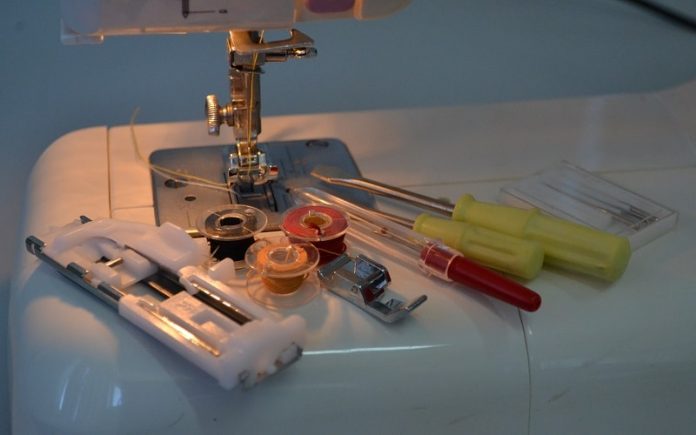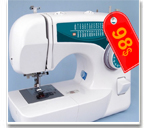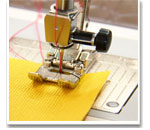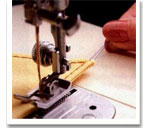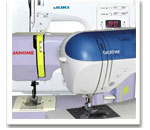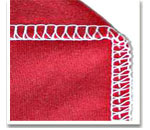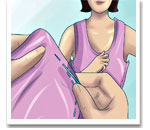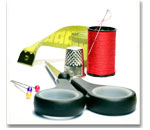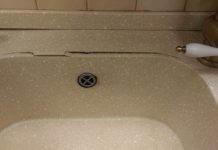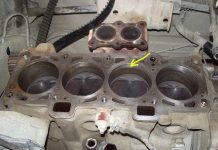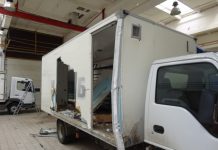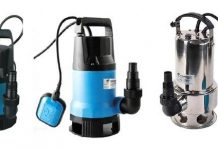In detail: manual sewing machine part 1 prevention DIY repair from a real master for the site my.housecope.com.
Complex repairs of sewing machines related to the adjustment of units and mechanisms can only be performed by an experienced master. But such repairs are rarely performed, only when a part breaks down at the sewing machine and needs to be replaced with subsequent adjustment.
Most often, the sewing machine starts to “play up” if the rules of its operation, specified in the instructions, are violated or if simple settings and adjustments are not followed.
The main reason leading to a sewing machine malfunction is sewing fabrics that are not intended for this sewing machine model. Sewing a double hem on jeans, replacing a zipper in a leather jacket or bag, etc. - this is the main reason for the appearance of gaps in the stitch, thread breakage, needle breakage. Sometimes this can even lead to a breakdown of the sewing machine, subsequent complex repairs associated with the replacement of parts.
This article provides basic recommendations on how to set up and perform a simple DIY repair of a sewing machine.
Oddly enough, but it is the needle that is the most important part of the machine. During its “life” it makes thousands of punctures in the tissue and is not always light and thin, so sooner or later the needle point becomes dull, and the needle itself bends. And if at least once the needle hits the metal part of the machine body, the tip will bend in the literal and figurative sense of the word.
However, do we pay attention to this? The needle seems to be intact, so everything is fine. But take a magnifying glass and look at its point, its blade will be bent to one side. How would such a point pierce the tissue? Only one way is to break it.
| Video (click to play). |
Now let's see how such a needle will form a stitch.
The thread passing through the eye of the needle will catch on the curved point and “slow down”, creating excess upper thread in the stitch. Here is the first reason the loops appear in the stitching. Moreover, the curved tip will cause periodic thread breakage, especially in difficult to sew areas, when the upper thread is extremely stretched.
It turns out that sometimes the whole repair of a sewing machine consists only in replacing the needle.
Treat the needle with great care. Even if it outwardly has no blade defects and is not bent, try to change them more often anyway.
You do not need to throw out the used needles, as there are situations when the needles break one after the other, for example, when sewing a leather bag. Then remember about the jar with old needles.
Another reason for adjusting the sewing machine, especially the old manual machines such as Singer or Podolsk, is the incorrect insertion of the needle into the needle bar. The needle blade (fig. B) should be on the side of the hook nose. Remove the stitch plate and see if this is the case if the machine suddenly begins to twist and break the thread.
It often happens that a seamstress installs a needle from an industrial sewing machine into a household sewing machine. It is impossible to confuse a household needle with an industrial needle. A household needle has a special cut on the flask (Fig. B). But, nevertheless, it is the industrial types of needles that are installed. This absolutely should not be done. Firstly, you break the gap between the hook point and the needle blade, hence the gaps in the stitches, and secondly, you risk damaging the sewing machine hook. Some commercial needles are noticeably longer than household needles and may touch the surface of the hook, scratch it or even damage the hook.
Figure (A) shows a diagram of how to check the curvature of the needle. Externally, the needle cannot be determined whether it is a curve or not, and if you put it on the glass (2), you can easily check the gap (1). Please note that an uneven, bent needle will cause gaps in the stitching and will break sooner or later.
To make the sewing machine “more confident” to work with fabrics that are difficult to sew, such as knitwear, stretch, thin natural and artificial leather, denim, needles are produced for sewing just such fabrics and materials. They have a special point shape and make it easier for the thread to pass through the fabric, almost eliminating skipped stitches and looping of the upper thread.
See Home sewing machine needles.
The thread looping in the stitching, as well as the characteristic knock during their operation, is perhaps the main difference between sewing machines with a zigzag, such as Chaika, Podolskaya 142 of all models. In short, the looping in the stitching occurs due to uneven tension of the thread along its path: broken compensation spring, rusty sole of the foot, incorrectly set shuttle, etc. However, it is impossible to set many parameters yourself without experience. Therefore, if you have a poor quality stitch, pay attention first of all to the condition of the needle, to the tension of the lower thread in the bobbin case, and whether the upper thread tensioner is working properly. Very often, children like to disassemble and assemble it, and after such a repair, the machine stops working.
It is sometimes necessary to repair the sewing machine Chaika quite often, and this is not due to the breakdown of parts, the parts are just very strong, but with the misalignment of the interaction of some units of the sewing machine, mainly the shuttle move.
Almost all of these tips for repairing a sewing machine Chaika can be used for other models of household machines.
First of all, check the nose of the shuttle with a magnifying glass; it should not have any chipping or rusty spots. If there are jags, they must be removed with a small file and polished to a shine, otherwise the thread will constantly linger behind the file marks and loops will appear below. Only this must be done carefully so as not to blunt the tip of the shuttle nose.
Sometimes the bobbin (the bobbin thread is wound around it) can cause repairs to the sewing machine. Yes, it is repair, since an inexperienced "master" often disassembles and assembles all the units, when it is enough to simply replace the old metal bobbin with a new plastic one. If the edges of the metal bobbin are jagged and the bobbin case itself is clogged with thread fleece, the bobbin thread will come out in jerks and the upper thread in the stitching will periodically loop from below.
Often the reason for contacting a sewing machine repairman is that the upper thread is poorly regulated. You are tightening it almost completely, but the tension is still too weak. Look, perhaps, between the tensioner plates, thread fluff has accumulated, which prevents the washers from fully squeezing. The fastening of the tensioner (Chaika) may have loosened.
But still, most often, sewing machines such as the Seagull have a malfunction in the parameters of the shuttle and the needle. This is a complex type of repairing a sewing machine, more precisely setting, but for general information it is advisable to know the main reason due to which all the "troubles" of sewing machines occur.
The most common cause of a sewing machine malfunction is the upper thread. Thread breakage, looping in a stitch, uneven stitching, skips, etc. This often depends on the upper thread tensioner.
It is the fastening of the tension regulator (Seagull) that most often causes its poor performance. The plastic body is pressed under the pressure of the screw and over time the tensioner begins to stagger, or even completely "falls out" of the body.
In this photo, arrows indicate the attachment of the needle bar and tensioner.When sewing rough fabrics, intersecting seams on leather goods, and especially when hemming jeans, the needle bar may move upward with the needle.
Loosen the screw slightly and adjust its position, making sure that the blade and needle groove are in the correct position in relation to the hook (not turning left or right).
For details on how to disassemble and assemble the sewing machine tensioner, see the article "The device of the sewing machine tensioner Chaika".
Adjusting the shuttle mechanism of sewing machines performing zigzag stitching by Chaika, Podolsk, Veritas and others implies setting the position of the looper point above the needle eye by 1.2 (3) mm at the moment the looper point approaches the needle. This parameter is checked when the sewing machine sews not only the straight stitch, but also the left and right needle drop (when sewing the zigzag stitch).
The point of the shuttle must at the same time pass almost closely to the blade of the needle - this is the second condition that allows you to form a stitch without gaps.
In this photo, the arrow indicates the fastening of the shuttle shaft. Loosen the screw with a 10-point wrench, and holding the handwheel by hand, you can turn the shaft (together with the shuttle stroke) by adjusting the position of the hook point in relation to the needle.
However, these are not all of the parameters for adjusting the interaction of the hook nose and the needle. There is such a parameter as the timeliness of the approach of the shuttle nose to the needle, namely at the moment when the needle starts to rise. The needle descends to the lowest point, and when raised by 1.8-2.0 mm, it should meet the nose of the shuttle, the shuttle removes the loop from the needle and wraps around itself.
But that's not all. For sewing machines performing a zigzag stitch, there is such a thing as right and left needle prick. With the left and right prick of the needle, the nose of the shuttle should “confidently” remove the loop formed above the eye of the needle. It should run slightly above the eye of the needle, but less than the distance of the eye of the needle itself, about 1 mm.
However, such adjustments are often not required to be performed, it is enough just to check with a magnifying glass how the shuttle interacts with the needle and make sure that repairs, adjusting the sewing machine are not needed, and look for another reason. For example, change the threads, thread them correctly, change the needle, clean the shuttle from dust and fleece, etc.
To make it easier for you to repair the sewing machine, disassemble the shuttle move and study its device. Observe how the stitch is formed when the stitch plate is removed. At the same time, check all the shuttle settings described above. See also How the sewing hook works.
The settings above can be used as a guide if you decide to repair your sewing machine yourself. As a rule, the machine will work normally with such gaps, but if you need to sew knitted fabrics that are too thin (silk) or, on the contrary, thickened fabrics, you need a more accurate adjustment of these parameters, which can only be set by the master.
In many cases, sewing machine repairs will not be necessary as long as the sewing machine is kept clean and lubricated periodically. If a seamstress takes care of her machine, then, therefore, she will protect it from overload during work, not let it into the “wrong” hands, which means that the sewing machine will break less often.
After prolonged operation, clean the bobbin compartment and other accessible places from dust, fleece, oil stains. The shuttle itself and the shuttle mechanism should be periodically cleaned with a stiff hair brush. It is advisable to lubricate the machine at least once every six months, and after lubricating it a little “idle” on it, especially if the machine is not used for a long time. During operation, the oil heats up slightly and penetrates better into units and places of friction.
It is better to draw machine oil into a medical syringe and bury it in small drops in accessible places where there is friction of metal parts.
The big enemy of all mechanisms is dirt and rust, try to keep the car in a cool, dry place. If the machine will not be used for a long time, protect it from dust, otherwise the oil from the dust will harden, and the machine will turn tightly, or even jam. This case is considered in the article Podolsk Manual Sewing Machine.
In this article, we will figure out whether such a combination is possible - "an inexpensive and good machine" and how an inexpensive sewing machine that costs 3-4 thousand rubles differs from a machine that costs 30 thousand.
Many who tried to sew knitwear on an ordinary sewing machine noticed that the machine often refuses to make a beautiful and even stitch. There are gaps in the knitted stitching, the lower thread loops and sometimes breaks. Why is this happening and how can you fix it?
The coverlock is a modern and versatile machine that can overcast fabrics, sew cover stitches and even stitch parts like a regular sewing machine. But it is impossible to repair such a sewing machine with your own hands, you must definitely contact the service center.
Sometimes it is required to make a perfectly even decorative stitching on a product, but you cannot draw a line with chalk - traces will remain, and there is not enough experience to scribble "by eye". Simple tips on how to sew on “difficult” areas.
For those who rarely sew simple products or occasionally perform minor repairs on clothes, you can buy an inexpensive economy-class sewing machine. It performs almost all operations, is easy to operate, and most importantly, for such a machine, it will be cheaper to build repairs if suddenly it is needed.
The overlock is much more complex than sewing machines. It is almost impossible to repair an overlock without special knowledge and skills. However, repair or adjustment is not always required, sometimes it is enough just to adjust the thread tension and it will again overcast the fabric with high quality.
How to sew a dress with your own hands. Technology and sequence of sewing dresses for beginners.
How to make a pattern, what tools are needed for this. These and many other tips for beginners.
Educational and educational blog about sewing machines at a professional level
Hello, thank you very much for such a helpful video. I have the same sewing machine as you have in the video. There is a problem with switching sewing modes, they are indicated by the letters H, W, H (the handle is barely wobbling, is in the W position). I lubricated the machine, as you showed in the video, it began to work much better, but the problem with switching H, W, N remained. Perhaps I did something wrong? Tell me what to do next.
Switching modes must be put on the letter H - this is the norm, W is silk for thin materials, V is embroidery on the hoop. You need to design a switch. Turn the car over - this is shown in this video for 6 min. 04 sec. on the upper shaft, right before your eyes, you will see the gearshift mechanism. It needs to be lubricated and switched with a knob until it is easy to switch.
Good day! I watch your videos all the time! Podolsk typewriter about 1972-heavy move. Disconnected all the connecting rods from the upper shaft, the course is still heavy. How to pull out the upper shaft or tell me what to do. Everything is blurred but the move is not the same.
It is not necessary to pull out the main shaft. It is most likely stuck in the bushings. Take a copper or aluminum adapter and place it on the left side of the shaft on which the crank is located, sharply but NOT STRONGLY hit it with a hammer. Try to scroll, if it does not help, hit the shaft on the right side, after removing the pulley.Then lubricate. Maybe the machine was greased with sunflower oil. On the parts, in the places of lubrication, there should be a deposit, like frozen viscous glue. I have used this method many times and it helped. And sometimes it did not help - then a complete disassembly.
Here I have the same device, tell me what it's called, I don't know, I got it by inheritance. I watched your video and noticed one nuance, when the machine was lubricated, you dripped oil on the “crouton,” so my car has a slight backlash in the place where the crouton walks along the fork. How can he affect the robot? And yet what problem is I going through a seam and she skips 1-2 stitches as when, what can it be?
Straight-stitching manual sewing machine PMZ (Podolsk mechanical plant). Small backlashes are allowed. The main thing is that the fork does not hang out on the tapered guides, it transfers the swinging movements to the shuttle. For omissions. Put in a new needle. The flask on the needle must be ground off. If there is still no result, lower the needle 1 - 1.5mm. If the gaps disappear, you will need to lower the needle bar. Write to help. And yet, if you DEPLOY from a large thickness to a thin one, there may be gaps.
After replacing the needle, the gaps disappeared, but the thread continues to break. I noticed that the needle enters the hole off-center, can this be the reason?
Yes maybe. But there could be many reasons. First of all, pay attention to the quality of the threads; the needle number does not match the thread number; not a quality needle; incorrect installation of the needle; incorrect threading; the thread guides are worn out; excessive thread tension; burrs may appear on the throat plate around the hole from the impact of the needle; hangnails on the shuttle; a steel plate is attached to the pusher carriage with two screws, which pushes the shuttle, look - these screws should sit tightly in the sweep, if there is a burr or a screw protrudes, a break occurs; the cap must be inserted into the hook and click into place, the latch must NOT move freely - it must be spring-loaded; the bobbin does not fully fit into the cap and the cap does not snap into place; the shuttle in the shuttle mechanism should have a slight play both in the seat and when the thread is dropped between the heel of the shuttle and the steel spring of the pusher.
These are all the reasons listed for which the upper thread may break, they also apply to all other sewing machines with such a swinging shuttle type.
Sewing machines do not lose their popularity even in the twenty-first century. Those who were born in the Soviet era remember that from childhood girls were taught to sew various things, from gloves to jackets and coats.
During the Soviet era, most people did their own sewing machine repairs. Even today, those who attend sewing and sewing courses understand that it is better to repair a sewing machine on their own than to take it to a service center:
- Firstly, companies that repair sewing machines demand quite a lot of money from their customers for the services they provide.
- Secondly, the device of even modern machines can be figured out in a matter of hours, one should only carefully approach this issue, and in the future this will allow repairing sewing machines without involving third parties.
Let's take a look at the basic rules for operating sewing machines:
- Sewing equipment should not be placed near batteries or heaters. But at the same time, it should be in a dry room, in which there are no signs of dampness;
- Before starting work, it is necessary to select the necessary materials and tools, needles and threads that will be needed in the process of work;
- Before you start sewing, you need to make sure that the needle and thread guide are in the up position;
- Remember that the sewing machine must be helped at the time of sewing by pulling the fabric towards you;
- After the sewing work is finished, raise the presser foot and pull out the fabric. Next, cut the thread, having found a free end in advance, the length of which will be equal to a maximum of seven, but at least five centimeters.

